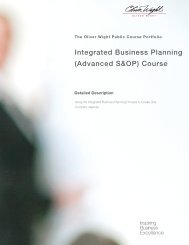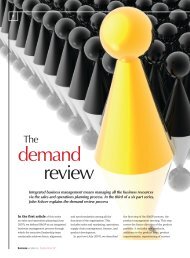Measuring Performance - Oliver Wight Americas
Measuring Performance - Oliver Wight Americas
Measuring Performance - Oliver Wight Americas
You also want an ePaper? Increase the reach of your titles
YUMPU automatically turns print PDFs into web optimized ePapers that Google loves.
<strong>Measuring</strong><br />
performance<br />
In part six of his series on managing and leading people,<br />
Jon Minerich, Principal, <strong>Oliver</strong> <strong>Wight</strong> <strong>Americas</strong>, Inc.,<br />
discusses the importance of performance measurement,<br />
and in particular, ensuring that the right things are measured<br />
6 www.bus-ex.com December 08
S t r a t e g i c m a n a g e m e n t<br />
Introduction<br />
<strong>Measuring</strong> performance is a perennial<br />
topic in the executive suite, in<br />
board meetings, and at meetings of<br />
management scientists. To paraphrase<br />
Dr. Deming, measuring performance<br />
is good; measuring the right things is<br />
the trick executives must learn.<br />
Today’s demanding business<br />
environment requires executives to<br />
regularly evaluate how they measure<br />
their company’s performance. Many<br />
CEOs spend significant time asking<br />
themselves what is the proper<br />
performance measurement process<br />
and structure, and what measures<br />
should we be using to drive business<br />
success?<br />
In this final article in our series on<br />
managing and leading people, we will<br />
explain how to create a performance<br />
management process that any CEO can<br />
use to 1) align performance measures<br />
to the company’s strategic objectives,<br />
2) create a performance culture, and<br />
3) cascade metrics to align, engage,<br />
and focus the organization on the<br />
company’s vision.<br />
Step 1<br />
Align your performance measures<br />
to your strategic objectives<br />
In our first article, “Achieve your<br />
company vision by developing your<br />
people strategy and leadership style”,<br />
we discussed how the vision was<br />
‘true north’ for your business, that<br />
strategies were the roadmap of the<br />
journey to the vision, and how values<br />
were the guideposts to decisionmaking<br />
along the way.<br />
When designing a performance<br />
measurement process, CEOs should<br />
begin by asking:<br />
1. Are the performance measures<br />
integrated and consistent, and do they<br />
drive performance toward the delivery<br />
of our vision?<br />
2. Do we have a balanced suite of<br />
measures that focus on the desired<br />
outcomes of our strategies?<br />
3. Do we have a structure that allows us<br />
to cascade our strategic performance<br />
goals down to the lowest level in our<br />
organization, enabling us to link<br />
progress on strategic objectives to the<br />
daily operation of the business?<br />
December 08 www.bus-ex.com 7
4. How do we evaluate whether or not<br />
we are living our corporate values?<br />
It is important to understand that<br />
CEOs must align their people and<br />
processes to the company’s vision<br />
and strategies. One way to do that<br />
is through performance measures. A<br />
second way is to ensure that everyone<br />
in the organization is living the<br />
company’s values.<br />
Please remember; company values<br />
guide decision-making. The types<br />
of decisions employees make on<br />
a daily basis directly impact the<br />
performance of the organization. So<br />
when designing their performance<br />
measurement process, CEOs should<br />
include a regular assessment, via<br />
surveys or other tools, about how<br />
well the values are demonstrated by<br />
everyone in the organization.<br />
CEOs must determine how to measure<br />
organizational success at the strategic<br />
level before they develop measures at<br />
the operational level. The definition<br />
of organizational success must also<br />
include the definition of organizational<br />
behaviors or culture of the company.<br />
How well leadership models define that<br />
culture is the most telling indicator of<br />
performance over time.<br />
Step 2<br />
Create a performance culture<br />
<strong>Performance</strong> management is the<br />
responsibility of the CEO and his/her<br />
top management team, not the HR<br />
department. The CEO must realize<br />
that operational or organizational<br />
performance drives financial<br />
performance and that appropriate nonfinancial<br />
performance measures must<br />
be developed. CEOs should begin by<br />
defining a performance culture for their<br />
companies.A performance culture is one<br />
that is success driven, process focused,<br />
and where everyone lives the company<br />
values every day. A success-driven<br />
company is one where everyone, from<br />
executives down to the administrative<br />
worker, has high expectations of<br />
performance, where failure is planned<br />
for and accepted, and where the good<br />
of the organization comes before the<br />
success of any individual.<br />
A process-focused company<br />
continuously improves its business by<br />
simplifying business processes, where<br />
fact-based decision-making is the rule,<br />
and where routine things are done<br />
routinely. Finally, a performance culture<br />
is one where, as mentioned above,<br />
everyone demonstrates the values in<br />
their day-to-day decision-making.<br />
CEOs should ask the following<br />
questions when evaluating their<br />
organizations’ culture:<br />
Success driven<br />
1. Do we expect success in everything<br />
we do, or are we risk adverse in our<br />
decision-making and goal setting?<br />
2. Do we plan for and accept occasional<br />
failure when driving to achieve our<br />
vision?<br />
3. Do the compensation system,<br />
performance appraisal process, and<br />
company recognition system support<br />
team or individual success?<br />
Process focused<br />
1. Does the top management team view<br />
end-to-end processes as critical to our<br />
future success, or do we still think in<br />
terms of functional organization and<br />
functional management?<br />
2. Do we continuously improve our<br />
business processes by measuring<br />
the velocity or agility of them? Do we<br />
continuously streamline and simplify<br />
our processes by eliminating the nonvalue<br />
added activities?<br />
3. Are decisions made and justified<br />
using relevant performance measures<br />
and accurate supporting data? (A quick<br />
test for CEOs is to closely watch the next<br />
management meeting. Do executives<br />
spend the majority of time discussing<br />
issues leading to a decision, or do they<br />
spend substantial time debating the<br />
data used to support decisions?)<br />
4. Do we have well-defined business<br />
processes, with clearly defined<br />
roles and responsibilities, where<br />
employees are empowered to make<br />
decisions without executive support,<br />
or do employees regularly request<br />
clarification of rules and procedures<br />
when attempting to make decisions?<br />
Demonstrated values<br />
1. Do members of our management<br />
8 www.bus-ex.com December 08
S t r a t e g i c m a n a g e m e n t<br />
team, both individually and<br />
collectively, model the behaviors we<br />
want to see in our company?<br />
2. Do our strategies align with our<br />
company values?<br />
3. When operating under stress or in<br />
“gray areas,” do all employees truly<br />
understand what types of decisions are<br />
acceptable and what types are not?<br />
Step 3<br />
Cascade your measures to align the<br />
organization<br />
Once they have defined the desired<br />
outcomes for each of their strategies, CEOs<br />
must create a performance management<br />
process that focuses, aligns, and engages<br />
the entire organization on implementing<br />
their strategies. The diagram below gives<br />
a simple framework to use in designing a<br />
cascade process.<br />
How a CEO measures performance<br />
can be as important as what they<br />
measure. <strong>Performance</strong> measures<br />
should be clearly identified as either<br />
1) learning or 2) compliance. Learning<br />
measures are trend measures. They<br />
show CEOs how well the company is<br />
improving or progressing over time.<br />
Compliance measures determine how<br />
well the company is operating within<br />
the “rules” or guidelines required by<br />
the board of directors, leadership<br />
team, or outside regulatory agency.<br />
At the strategic level, metrics<br />
generally focus on measuring progress<br />
over time toward strategic objectives<br />
and the company’s vision. Therefore,<br />
they are learning in nature. As<br />
measures are cascaded down through<br />
the organization, metrics become more<br />
process focused and are a combination<br />
of both learning and compliance<br />
measures. Savvy CEOs will ensure that<br />
performance measures are balanced<br />
between both learning and compliance.<br />
Every CEO should ask these key<br />
questions:<br />
1. From the strategic level on down<br />
to the lowest operational level, are<br />
the performance measures mutually<br />
supporting and integrated?<br />
2. Do we have a balanced set of<br />
measures that include both learning<br />
and compliance metrics?<br />
3. Is it obvious to employees how their<br />
performance measures are linked to<br />
and support strategic goals?<br />
4. Do key performance measures focus<br />
on supporting end-to-end business<br />
processes necessary to compete in<br />
today’s business environment or are they<br />
predominantly functionally oriented?<br />
5. Are our performance measures<br />
focused on meeting changing<br />
customer and market requirements,<br />
or are we just measuring our internal<br />
improvements over last year?<br />
Conclusion<br />
<strong>Measuring</strong> organizational performance<br />
is not easy. CEOs should put into context<br />
how their business must perform in the<br />
future state or vision they have defined.<br />
They should align their performance<br />
measures to the strategic objectives<br />
they have set to achieve that vision. A<br />
critical component to achieve the vision<br />
is a performance culture. Defining this<br />
culture is critical to long-term success.<br />
Finally, performance measures<br />
must focus, align, and engage the<br />
organization to achieve both the<br />
company’s vision and strategic<br />
objectives. They must be cascaded<br />
down throughout the organization so<br />
every employee clearly understands<br />
how their performance is linked to and<br />
impacts the strategic objectives of the<br />
company. Accomplishing all of these<br />
things is not easy and CEOs must<br />
spend significant time developing the<br />
performance management process.<br />
Throughout this series, we built<br />
a framework for CEOs to follow in<br />
developing their “people strategy”. In<br />
it we have covered six key areas:<br />
1. Strategy & leadership<br />
2. Designing & developing your<br />
organization<br />
3. Change management & learning<br />
4. Developing people<br />
5. People in teams<br />
6. <strong>Measuring</strong> performance<br />
Our intent was to foster thoughtful<br />
discussion in the executive suite<br />
on a topic that is critical to every<br />
organization—managing and leading<br />
people. We encourage executives to<br />
go far beyond the boundaries of this<br />
series and create their own competitive<br />
company in these challenging times.<br />
Good luck! We would be delighted to<br />
hear about your success!<br />
December 08 www.bus-ex.com 9

















